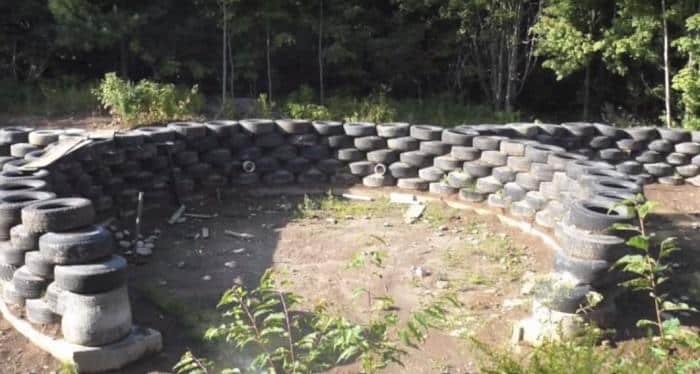The off-grid and homesteading lifestyle has a tremendous amount of appeal for many. In a time of seemingly ever-increasing instability in our world, the idea of living in a truly self-reliant and sustainable way is more attractive than ever.
With that spark of enthusiasm, visions of silver solar panels, white wind turbines, and a sprawling timber home are often not far behind.
The reality for most, though, is that building a traditionally constructed home on our land is both time and financially prohibitive.
This is where non-traditional construction methods and materials enter. By non-traditional, we simply mean homes that are not primarily constructed of new lumber, bricks or stone. In their place, homebuilders utilize low-cost eco-friendly or reclaimed materials, and the construction time and skill required is most often greatly diminished.
In this article, we have gathered three of the most predominantly used, non-traditional building materials people are creating homes with. They are elegantly simple and unique in shape, character and function.
So without further comment, welcome to this episode of “This Weird House.”
1. Tires: getting traction in construction
Strictly from an environmental perspective, used vehicles tires can be a bit troublesome. Although not exactly the longest in regards to decomposition time (50-80 years), they are plentiful, unsightly and a haven for mosquito breeding.
Fortunately, many companies have recognized these mountains of rubber as a commodity and have begun “upcycling” them. Typically, you will find them shredded into pieces and used as mulch at playgrounds and pavement material for running tracks and the like.
Given as most tire dealers were paying around $2 and up for used tire disposal, it was just a matter of time when someone would see this endless supply of free resources as an asset worth working with in the way of homebuilding.
Story continues below video
The usage of tires as a construction material can likely be credited to the “earthship” movement which started approximately 40 years ago. Today, these earthships utilize tires, which are rammed inside and between with compacted earth, to make up the outside and structural walls of the structure. Stacked flat and in courses much like masonry bricks, it is a construction technique that literally anyone can perform and virtually free of cost.
The other variation to this method is the usage of “tire bales.” What is a tire bale, you ask? A tire bale is simply a huge block of 90-120 tires which have been compressed. The bales are usually around 60 inches long, 50 inches wide, and 30 inches tall. Each bale weighs in at an impressive 1 ton and has an astonishing insulation value of R-186!
Despite their heavy nature, these bales make for quick construction and amazing heating/cooling efficiency. Having been used in the past for construction sites, retaining walls and windbreaks, they are now coming into prominence as a homebuilding material.
To learn more, visit tirebalehouse.com or earthship.com.
2. Shipping containers
Survivalists have been using shipping containers as the foundation of apocalypse shelters and underground bunkers for decades.
But their use need not be limited to a hole in the ground or a glorified metal shoe box with a door. No, creative types across the globe are applying some innovative designs to these ship-worthy hunks of square steel, and the results are downright impressive.
Story continues below video
As the usage of these containers has grown, so has the amount of them used in a building. With a bit of skill and a torch, one can connect several units together to create a modular living structure that goes up quickly and structurally, stands the test of time.
Given a starting price for a typical used shipping container coming in at around $2,000, it is easy to see how this affordable, nearly instant housing concept is taking off.
If you would like to find shipping containers for your next construction project, you can visit Cubedepot.com for local inventory and pricing.
3. House of straw
Does that title conjures thoughts of instability and childhood stories about the three little pigs for you? Maybe thinking how it didn’t work out so well for the pork trio? Set aside, for a moment, your preconceived notions in regards to the stability of straw. We are talking about straw bale construction here, and this is no fairy tale.
Aside from the obvious easing of construction time, straw bale houses are roughly three times greater in energy efficiency than conventional lumber framing. This is due to the fact that the bales (along with the stucco) create the whole of the wall unit. Structure and insulation in one block.
When many people hear about the notion of building a home made of highly combustible straw, their thoughts immediately turn to a raging inferno. The truth is that straw bales are so tightly compacted, they leave very little room for oxygen to enter and end up being a safer option than timber framing. In fact, the average lumber home took only 30 minutes to one hour to catch fire in recent tests. The straw bales took three hours (source: strawbale.com).
Another benefit to straw bales is their incredible ability to absorb sound. This is a wonderful quality if you don’t wish to hear activities between rooms of your home.
Lastly, some people who are considering straw bale construction may be concerned that the straw might decompose over time. Worry not. The process of decomposition requires two critical thing:; water and oxygen. Your straw bales, if properly built, will have neither in your construction.
I hope we have inspired you to look at the many different options available for your next construction project. This is but a sample of the innovative ways you can build quickly and economically. Now have fun … and go exploring!
Related:
How To Build A $1,000 Indestructible Off-Grid Home
How To Live Off-Grid With A Full-Time Job (In A Straw Bale Home)
What is your favorite off-grid building material? Share your thoughts on off-grid construction in the section below:

